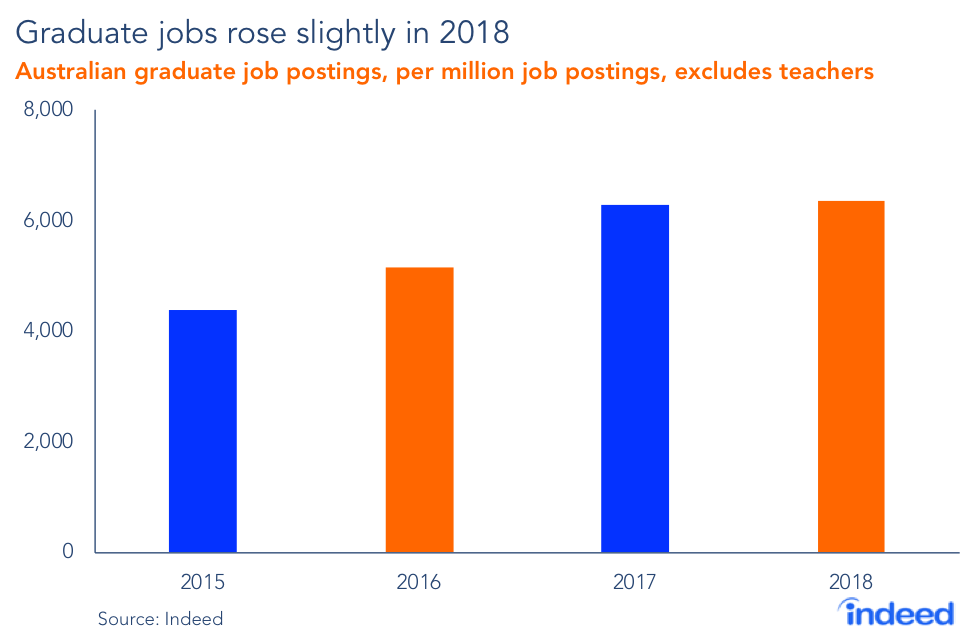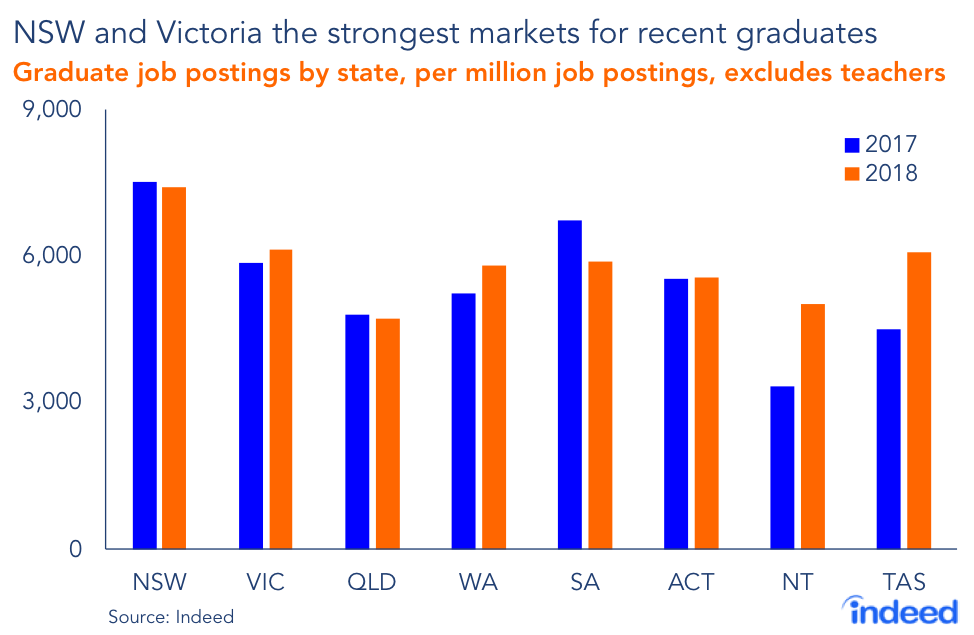Key points:
- The market for new graduates performed well in 2018, with job postings consolidating the massive gains in 2017.
- New South Wales and Victoria led the way for graduate job postings, while opportunities in Western Australia continued to rebound.
- Teaching was once again the leading occupation for graduate job postings, at least partly reflecting how these jobs are advertised. Graduates in accounting and civil engineering were also spoiled for choice.
For university students, the final year of study is often a difficult balancing act between school and applying for full-time work. Some graduates lock in a job early, waiting out the school year until their new career begins. Others face a hectic end-of-year scramble. Different fields advertise at different times of the year, so half the battle for graduates is knowing when to look for jobs in their areas. Competition is fierce. If history is any guide, around a quarter of undergraduates will fail to find full-time work within four months of completing their degree.
The good news though is that the graduate job market is healthy and has improved noticeably in recent years, which provides more opportunities for those about to complete their studies. Using Indeed job posting data, including both the number and timing of job listings, we found:
- Around 22% of graduate job postings are for teachers, though differences in how graduate teacher jobs are advertised, discussed below, make direct comparisons with other occupations difficult. Accountants and civil engineers also rank highly.
- Excluding teachers, the graduate job share of total postings rose slightly in 2018 after rising almost 22% in 2017.
- New South Wales and Victoria led the way in graduate job postings, creating an incentive for recent graduates to head east in search of opportunity.
Why are there so many postings for graduate teachers?
In 2018, around 22% of graduate job postings were for teachers. These opportunities cover a bit of ground, including kindergarten, primary and secondary school teachers, special needs teachers and specialised university postings. Opportunities for graduate teachers typically appear online later in the year, from September through the new year.
The dominance of teaching among graduate jobs reflects how these jobs are advertised. A ‘Big 4’ accounting firm might post a single ad for its graduate program and accept thirty applicants. In contrast, a posting for a graduate teaching program will often be for one specific job. Thus, a single graduate job posting in accounting, nursing or engineering will typically result in a higher number of jobs than a graduate job posting for teachers.
To allow an apples-versus-apples comparison, we have excluded teachers from our analysis. The table below shows the occupations other than teaching with the greatest number of graduate opportunities and notes the best time to search for a job.
Accounting and civil engineering lead the way
Evergreen occupations such as accounting and civil engineering fare well. These opportunities appear early in the year, typically around March, although aspiring accountants can still find plenty of openings later in the year.
Architectural graduates always rate highly, as do nurses who labor in an occupation in which there is never a shortage of demand. A range of tech roles also feature in the top ten graduate occupations, including programmers and software engineers. In fact, computer programmer is the occupation in which you are most likely to find graduates in the workplace—13.6% of all job listings for computer programmers were graduate postings.

How is the graduate market faring overall?
Hiring conditions for recent graduates have generally improved in recent years. In 2018, graduate job postings climbed slightly from a year earlier following a 22% rise in 2017. If teaching roles were included, overall graduate opportunities would have been much higher than in 2017. This is encouraging for younger workers, who for the best part of a decade have struggled to find full-time work immediately out of university.

Around 73% of recent graduates landed full-time work within four months of graduating in 2018, according to the 2018 Graduate Outcomes Survey. Indeed’s figures on graduate job postings in 2018, primarily covering graduates who begin work in 2019, suggest the graduate market is continuing to improve.
For those who do miss out in the post-graduation scramble, there’s no need to despair. Persistence is the name of the game for graduates. In the long-term, university graduates do better in the labour market than do non-graduates in both employment and earnings. In 2015, just 67% of recent graduates landed full-time employment within four months of graduating, but three years later, 89% had found full-time work, according to the 2018 Graduate Outcomes Survey (Longitudinal).
As for regional trends, New South Wales and Victoria were the strongest markets for recent graduates. Australia’s two largest states have been key growth drivers in recent years thanks to their status as financial and service sector centres. The concentration of graduate opportunities in these states suggests Sydney and Melbourne may attract highly skilled graduates from other parts of the country as they begin their careers.
Some smaller states and territories also posted strong growth in graduate opportunities, including Tasmania and Northern Territory. But the raw number of jobs in these regions remains low. Perhaps the most encouraging development was improvement in Western Australia, where the labour market has struggled since commodity prices collapsed in 2013.

Still, in the year ahead, graduate opportunities could come under pressure from slowing economic conditions in New South Wales and Victoria. Falling property prices have many analysts concerned about the economic outlook for Sydney and Melbourne. This could create opportunities for other states and territories to hold onto highly skilled talent. At the same time though, weakness in Australia’s two largest states could produce a glut of graduates that the smaller states won’t be able to absorb.
Methodology:
To analyse employment outcomes of recent graduates, we used job posting data for Australia that filtered for job titles including the word ‘graduate’. This identifies Australian employer graduate programmes and opportunities that mainly go to students completing the final year of undergraduate study.
Job postings have limitations as a measure of graduate job opportunities. First, the number of advertisements is not the same as the number of jobs available. Some listings refer to ‘graduate programme’, which means that a single posting could refer to multiple positions. Second, not every graduate opportunity is posted online. In some occupations — for example, medicine — graduates find employment through placements rather than online job postings.
